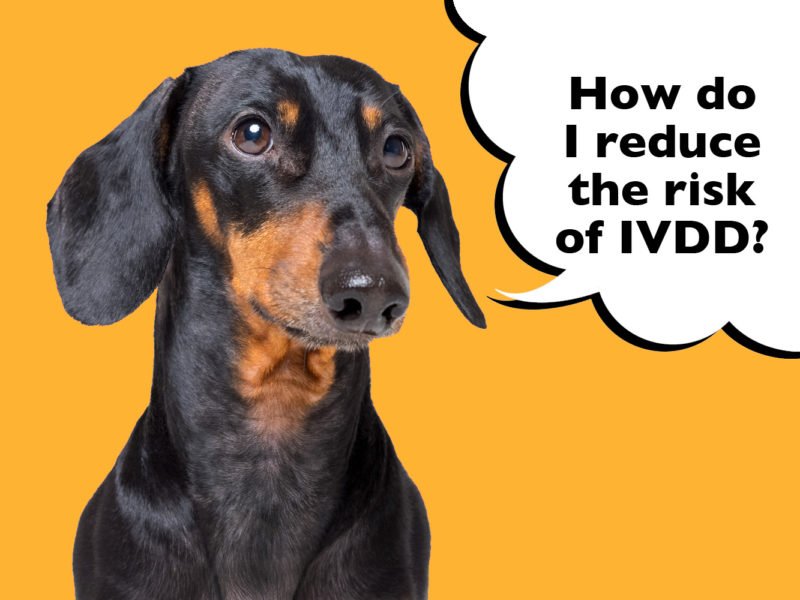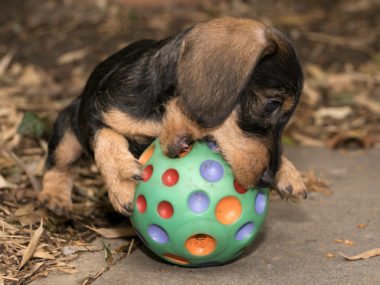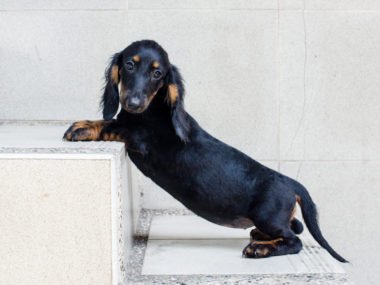Do you want to know how to reduce the risk of IVDD (Intervertebral Disc Disease) in Dachshunds? Want to find out the best lifestyle changes you can make to keep your Dachshund fit and healthy? Here’s everything you need to know about how to reduce the risk of IVDD in Dachshunds.
How To Reduce The Risk Of IVDD In Dachshunds:
- Keep your Dachshund at a healthy weight
- Feed your Dachshund a balanced diet
- Don’t neuter your Dachshund until they’re fully grown
- Don’t over-exercise your puppy in the first 12 months
- Take your Dachshund for regular daily exercise
- Don’t allow your Dachshund to jump on and off the furniture
- Strengthen your Dachshund’s back
- Lift and hold your Dachshund correctly
- Train your Dachshund to walk on a loose leash
- Keep your Dachshund’s nails trimmed
- Keep an eye out for symptoms of back pain
Read on to find out what IVDD actually is, what age Dachshunds get IVDD, and how you may be able to reduce your Dachshund’s risk of IVDD through some simple lifestyle changes.
Table of Contents
This article is based on research and personal experience as a Dachshund owner of 10+ years. I am NOT a Vet or qualified Dog Trainer. These lifestyle changes are just suggestions and some Dachshunds will sadly still go on to get IVDD. Sometimes it’s hereditary and there’s simply nothing you can do. If you notice any signs of back pain, take your Dachshund to the vet immediately for treatment.
What Is IVDD In Dachshunds?
Intervertebral Disc Disease or IVDD is a painful and debilitating back condition for Dachshunds which can sadly lead to paralysis in extreme cases.
IVDD is where a disc in your Dachshund’s spinal column ruptures or bulges, which leads to calcification. This puts severe pressure on your Dachshund’s spine and causes extreme pain when they try to move.
Unfortunately, IVDD is a common back disease with research suggesting one in four Dachshunds are affected.
The reason Dachshunds are particularly at risk of IVDD is because of the same dwarfism gene which is responsible for their stunted legs.
This genetic mutation causes their spinal discs to start deteriorating at a much younger age than other dog breeds with normal length legs.
In general, Dachshunds are more at risk of IVDD from age 3 to 7 when they’re younger and more playful. But, sadly, an IVDD episode can happen at any age.
However, it’s not just Dachshunds that are predisposed to this painful back condition. Other dog breeds like beagles, corgis, bulldogs and shih tzus are also at risk.
Can You Avoid IVDD In Dachshunds?
No, unfortunately, you can’t ever avoid IVDD in Dachshunds completely. Sometimes it’s hereditary and there’s simply nothing you can do to stop it from happening.
However, there are are numerous lifestyle changes you can make that may help to reduce the risk of IVDD in Dachshunds.

How Do I Reduce My Dachshund’s Risk Of IVDD?
The following suggestions may help to reduce your Dachshund’s risk of IVDD:
Keeping your Dachshund at a healthy weight may help to reduce the risk of IVDD
Obesity is one of the leading factors that could increase your Dachshund’s risk of IVDD.
Dachshunds who are overweight will have extra strain put on their back and spine, making them more likely to suffer from disc herniation.
You can check if your Dachshund is overweight by feeling his ribs. If you can’t feel his ribcage, he probably needs to lose some weight!
However, if your Dachshund’s ribs are really visible and protruding, then he could actually be underweight.
For optimal health, it’s important for your Dachshund to be at the ideal weight for his size!
If you want to know what weight your Dachshund should be, then click here!
Feeding your Dachshund a balanced diet may help to reduce the risk of IVDD
Make sure you feed your Dachshund a balanced and healthy diet.
Give your Dachshund the best dog food you can afford and keep things as natural as possible.
Try to avoid any chemicals or artificial additives and things like fillers that are just used to bulk up the dog food.
It may also be best to steer clear of any foods that have a high proportion of grains like wheat or soy, as some Dachshunds can be allergic.
Inflammation is a central factor in the cause of spinal issues like IVDD. But, interestingly, Omega 3s are said to help reduce inflammation.
Dogs don’t produce essential fatty acids like Omega 3 or 6 on their own. This means they have to get these nutrients from either food or supplements.
So it may be a good idea to introduce some salmon dog food or dog treats into your Dachshund’s diet.
Don’t rush in with supplements though. You need to speak with your vet before giving your Dachshund any supplements. You don’t want to cause a nutrient imbalance!
The vet may also make diet suggestions depending on your Dachshund’s age and any other health conditions he may have.
If you want to know what you should feed your Dachshund, then click here!
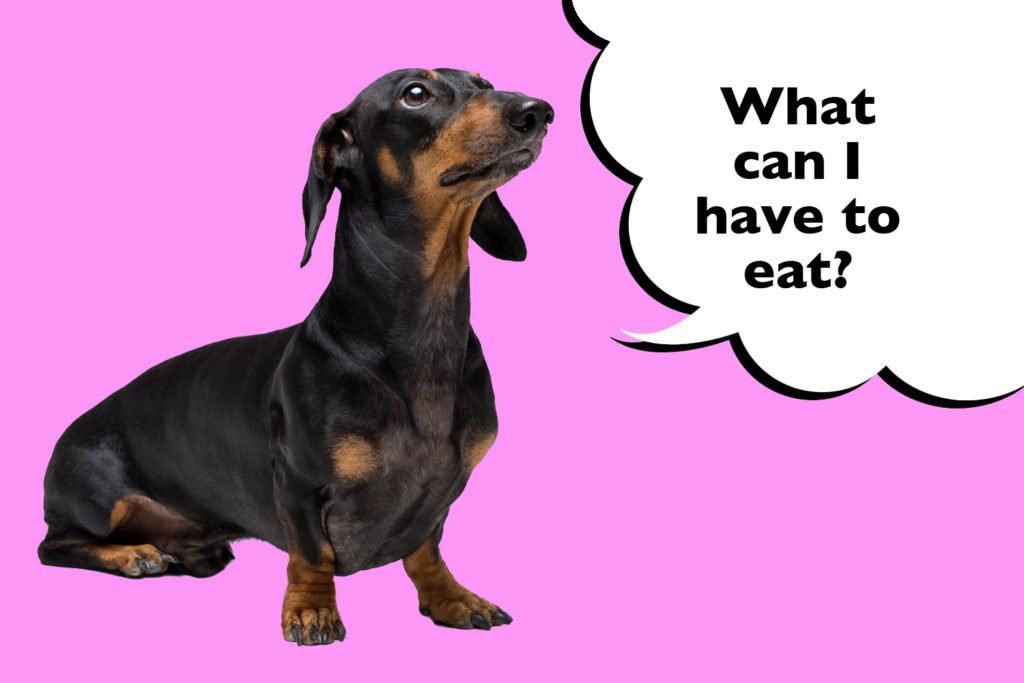
Don’t neuter your Dachshund until they’re fully grown to potentially reduce the risk of IVDD
In the UK, there was a research study done that concluded early neutering or spaying (under 12 months of age) increased the risk of IVDD in Dachshunds.
Most owners from Dachshund Facebook Groups in the UK suggest the best age for neutering or spaying is around 18-24 months.
This is to give Dachshunds enough time to both physically and mentally mature before stopping their hormone production.
However, female Dachshunds can be prone to Pyometra infections (which can sadly be fatal).
The risk of infection is increased after each heat cycle, so that must also be taken into account.
Opinions on the best age to neuter or spay a Dachshund will vary depending where people live in the world.
But, it’s a good idea to take a look at this study because it does show a clear link between IVDD and early neutering in Dachshunds.
Holding off a few months to reduce your Dachshund’s risk of getting IVDD may well be worth doing.
The best thing you can do is to speak with your Vet and share this study showing the link between IVDD and early neutering with them.
And hopefully there’ll be more research to back this study up in future!
Don’t over-exercise your Dachshund puppy in the first 12 months of life
Dachshund puppies need time for their muscles and bones to properly develop in the first 12 months of life.
Going on long walks or walking too fast when your Dachshund is too young may increase his risk of IVDD and other joint related problems.
It’s recommended that Dachshund puppies stick to the ‘5 minutes per month of age’ rule. This is where you exercise your puppy for 5 minutes for every month of their age.
So, a 3 month old puppy would need 15 minutes of formal leash walking exercise a day, and a 4 month old puppy would need 20 minutes – and so on.
However, that rule doesn’t include fun time! You can also play with your Dachshund at home or in the garden or yard for longer than this.
You just have to be sure your yard is secure and your Dachshund is off leash when he’s playing so there’s no strain being put on his back.
If you want to know when Dachshunds are fully grown, then click here!
Taking your Dachshund for regular daily exercise may help to reduce the risk of IVDD
It’s recommended that your adult Dachshund gets at least 30 minutes of exercise each day.
Standard Dachshunds will obviously need more exercise than miniatures, and most will happily exercise for around an hour.
Dachshunds who don’t get enough exercise may be at increased risk of suffering from IVDD.
Exercising builds muscle and helps maintain a healthy body condition, meaning it could reduce the risk of IVDD.
When your Dachshund exercises, he’s strengthening muscles which support his long spine.
This may potentially lower the risk of IVDD, because the risk of a disc slipping is lessened by a strong back.
It’s recommended you take your Dachshund for a walk partially on and off the leash at least once a day to help prevent IVDD.
However, doing exercise with your Dachshund doesn’t just mean going for a walk!
It can also include playing in the yard or garden or doing dog training activities too!
If you want to know how much exercise your Dachshund needs, then click here!
Stopping your Dachshund from jumping on and off the furniture may help to reduce the risk of IVDD
High impact activities such as jumping on or off furniture or going up and down stairs may be dangerous for your Dachshund.
Over time, these repetitive movements could put stress on your Dachshund’s back and may increase his risk of IVDD.
It’s a good idea to install baby gates on the stairs and train your Dachshund to use a ramp to get on and off the sofa or bed.
You can also lift your Dachshund up and down from any furniture. But only do this if he’s happy to wait for you and doesn’t get over-excited and try to jump off!
You just want to try and prevent your Dachshund from making big leaps and jumps and over-stretching himself every day.
It’s never going to be perfect as dogs will be dogs, but just do your best to limit those big jumps as much as you can!
If you want to know how to train your Dachshund to use a dog ramp, then click here!
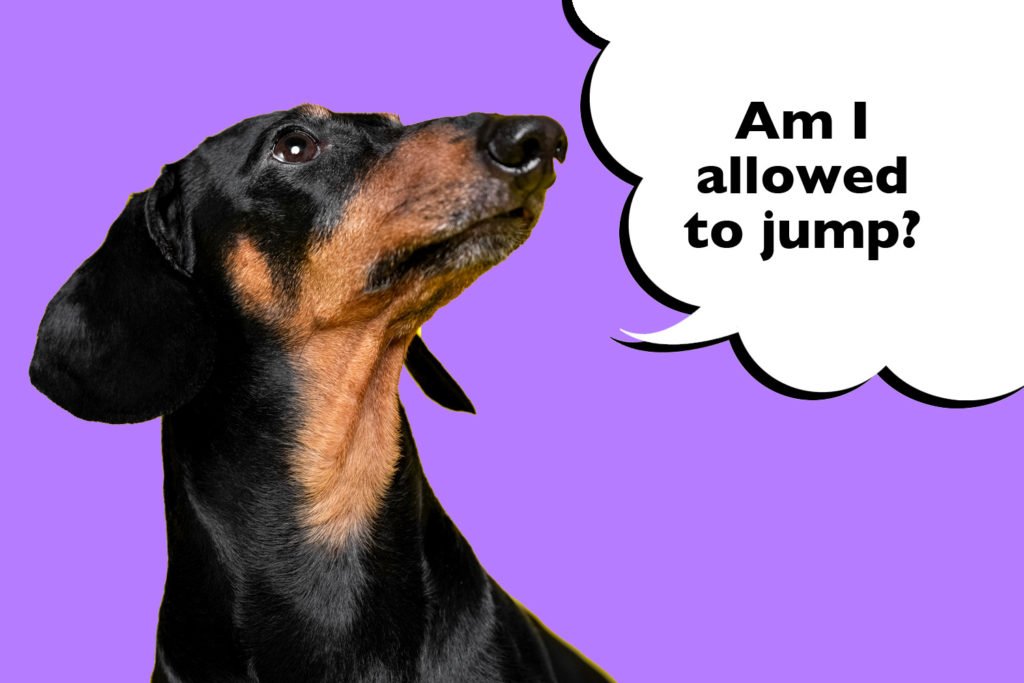
Strengthening your Dachshund’s back may help to reduce the risk of IVDD
As much as you’ll want to protect your Dachshund from jumping and hurting his back, it’s important you don’t wrap him up in cotton wool!
At the end of the day, Dachshunds were originally bred to be hunting dogs to dig down into burrows and catch badgers – so they’re tougher than you think!
If you stop your Dachshund doing anything and everything, he won’t build the muscle strength needed to keep his back healthy and strong.
Ideally, you need him to maintain a solid core and shoulder muscles, without over-straining his back by jumping too high or down from any height.
Allowing your Dachshund to play with other dogs is a great way to do this and hopefully reduce the risk of IVDD too.
So, if you have another Dachshund or any other type of dog at home, or maybe even a friend’s dog, it’ll be good for them to play.
It’s thought that playing with other dogs is a very important form of exercise for maintaining strong back muscles.
If you don’t know anyone with dogs, just take your Dachshund to the dog park or join a Dachshund Facebook Group walk and let him run free!
There are also many easy-going training exercises you can do with your Dachshund at home to help strengthen his back and keep him active.
Your overall aim is to just keep your Dachshund fit, healthy and strong, to give him the best chance of avoiding an episode of IVDD!
Lifting and holding your Dachshund correctly may help to reduce the risk of IVDD
Lifting and holding your Dachshund the wrong way could increase his risk of IVDD.
When lifting your Dachshund, always make sure you have one arm under his chest and the other arm under his hindquarters (or butt!).
When you lift him up, try to keep his back as straight as possible. You want to try and prevent any unnecessary strain or bend on his spine which could lead to injury.
Never lift your Dachshund by the front paws or let his back legs dangle down. This is a complete no-no, and that must also be explained to children!
Always place your Dachshund back down on the floor gently and slowly. Never drop him from any height onto the ground as this could cause damage to his back.
If you want to find out more ways to care for your Dachshund’s back, then click here!
Training your Dachshund to walk on a loose lead may help to reduce the risk of IVDD
The collar vs harness debate is one that Dachshund owners may never fully agree on.
For the most part, using a well-fitting harness on an adult Dachshund can be a more gentle solution that reduces the risk of IVDD.
Harnesses spread the pressure across your Dachshund’s body and may stop him pulling so much on walks.
However, harnesses can also rub and may restrict movement under your Dachshund’s legs and around the shoulder area.
The strap underneath could make your Dachshund change the way he walks and put pressure on his lower back.
Dachshunds have long bodies and short legs, making harnesses more problematic than they would be for other longer-legged breeds.
Puppies are at particular risk of injury while they’re still developing and not yet fully grown.
Harnesses are not only restrictive but they can also be heavy (even the lightweight ones!).
For adults, it’s normally fine. But, for puppies, that extra weight on the back does need to be a consideration.
On the other hand, a collar will allow your Dachshund to move naturally and not be restricted or rubbed by the harness.
However, if you have a lively Dachshund that pulls on the leash, a collar is much more of a risk factor when it comes to IVDD.
So, whichever side of the fence you’re on, there are many pros and cons to both collars and harnesses!
But, regardless of the equipment you use, if your Dachshund is constantly pulling while on the leash, he’s going to be more at risk of IVDD!
So, the most important thing here is that you teach your Dachshund to walk nicely on a loose leash. No pulling, lunging or straining.
That way it won’t matter if you choose a collar or a harness, because your Dachshund will be walking nicely by your side!
If you want to find out how to teach your Dachshund to walk nicely on a leash, then click here!
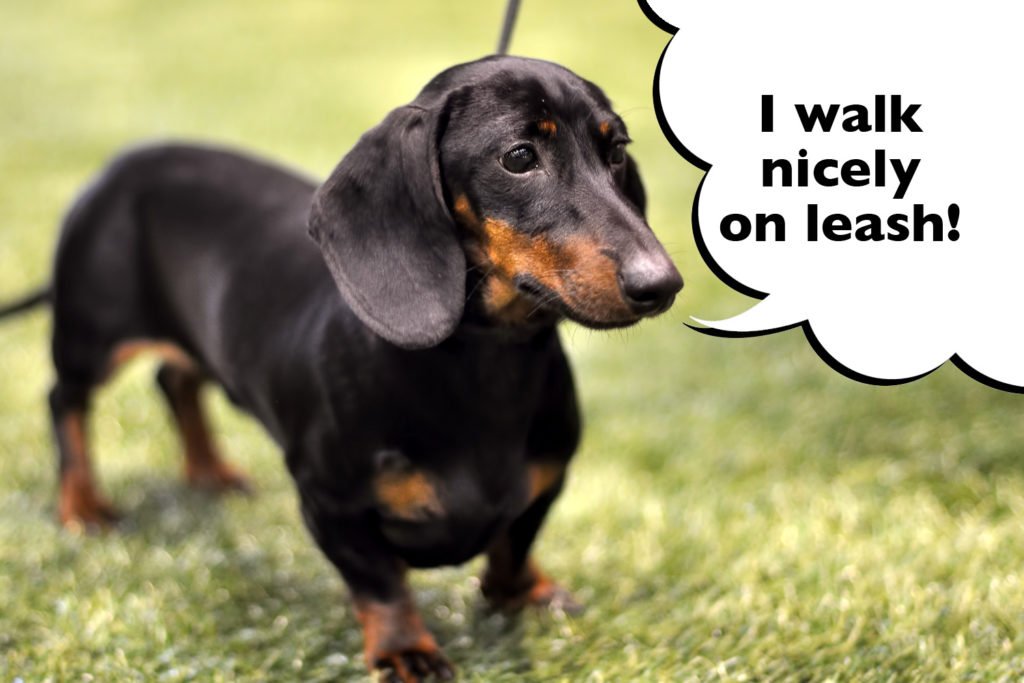
Keeping your Dachshund’s nails trimmed may help to reduce the risk of IVDD
Your overall goal is for your Dachshund to have a strong, healthy back, so trimmed nails are essential!
If your Dachshund’s nails are too long, it could affect his posture and make him adjust the way he walks.
If he starts walking differently, those long nails could put him at risk of back and spinal problems.
That’s why your Dachshund’s nails need to be checked weekly and should be trimmed at least once every month.
Of course, this does depend on whether your Dachshund walks on hard surfaces or not. If he does, his nails may not need cutting so often.
For reference, your Dachshund’s nails should sit just above the ground so they don’t make contact with it at all.
A good way to know if they’re too long is to listen out when your Dachshund is walking along a wooden or tile floor.
If you can hear the taping sound of the nail touching the floor, you’ll know it’s time for a trim!
If you want to know how to cut your Dachshund’s nails, then click here!
Keep an eye out for symptoms of back pain to give your Dachshund the best chance of making a full recovery
The severity of IVDD increases the longer the symptoms that your Dachshund exhibits go unnoticed.
Pressure on a Dachshund’s spinal cord for an extended amount of time can lead to irreparable damage.
So keep an eye out for any changes in your Dachshund’s normal movements.
For example, if your Dachshund is struggling to walk or stumbling around, if he flinches when you touch him, has an arched or tense back, is reluctant to move or has a lowered head, then he may be experiencing back pain.
If you spot any unusual signs or think your Dachshund is in pain, you must get your Dachshund checked immediately by a vet.
The quicker you act, the better the chance your Dachshund will have of making a full recovery!
If you want to know what to do if your Dachshund has an IVDD emergency, then click here to find out!
So, there you have it! Even though you can’t avoid IVDD in Dachshunds completely, there are some lifestyle changes you can make that may help to reduce the risk. So keep up the exercise routines and watch your Dachshund’s weight, make sure you’re holding him right, limit those jumps and get a ramp for the sofa and bed!
I am NOT a Vet or qualified Dog Trainer. These lifestyle changes are just suggestions and some Dachshunds will sadly still go on to get IVDD. Unfortunately, you can’t avoid IVDD in Dachshunds completely. Sometimes it’s hereditary and there’s simply nothing you can do. If you notice any signs of back pain, take your Dachshund to the vet immediately for treatment.
What do I do next?
If you read all the way to the end of this article, you’re exactly the sort of person I’d LOVE to join my Facebook Group. Your support for my blog means everything to me so, if you found this article helpful, please kindly share below. Thank you! 💋


